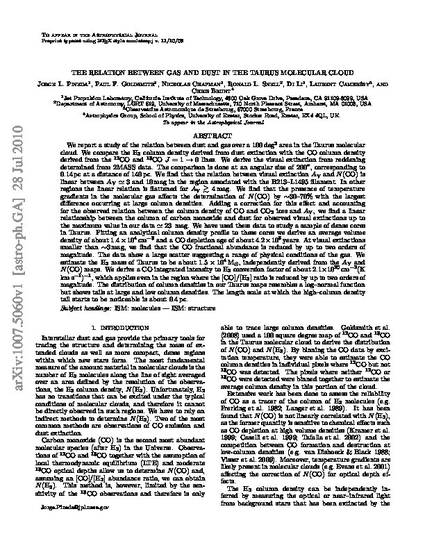
We report a study of the relation between dust and gas over a 100 deg2 area in the Taurus molecular cloud. We compare the H2 column density derived from dust extinction with the CO column density derived from the 12CO and 13CO J = 1 → 0 lines. We derive the visual extinction from reddening determined from 2MASS data. The comparison is done at an angular size of 200'' corresponding to 0.14 pc at a distance of 140 pc. We find that the relation between visual extinction A V and N(CO) is linear between A V 3 and 10 mag in the region associated with the B213-L1495 filament. In other regions, the linear relation is flattened for A V 4 mag. We find that the presence of temperature gradients in the molecular gas affects the determination of N(CO) by ~30%-70% with the largest difference occurring at large column densities. Adding a correction for this effect and accounting for the observed relation between the column density of CO and CO2 ices and A V, we find a linear relationship between the column of carbon monoxide and dust for observed visual extinctions up to the maximum value in our data 23 mag. We have used these data to study a sample of dense cores in Taurus. Fitting an analytical column density profile to these cores we derive an average volume density of about 1.4 × 104 cm–3 and a CO depletion age of about 4.2 × 105 yr. At visual extinctions smaller than ~3 mag, we find that the CO fractional abundance is reduced by up to two orders of magnitude. The data show a large scatter suggesting a range of physical conditions of the gas. We estimate the H2 mass of Taurus to be about 1.5 × 104 M , independently derived from the A V and N(CO) maps. We derive a CO integrated intensity to H2 conversion factor of about 2.1 × 1020 cm–2 (K km s–1)–1, which applies even in the region where the [CO]/[H2] ratio is reduced by up to two orders of magnitude. The distribution of column densities in our Taurus maps resembles a log-normal function but shows tails at large and low column densities. The length scale at which the high column density tail starts to be noticeable is about 0.4 pc.
Available at: http://works.bepress.com/ronald_snell/14/

This is the pre-published version harvested from ArXiv. The published version is located at http://iopscience.iop.org/0004-637X/721/1/686/